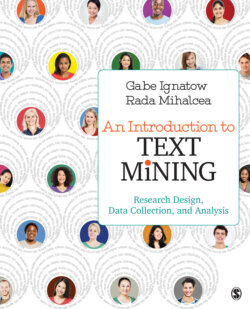Читать книгу An Introduction to Text Mining - Gabe Ignatow - Страница 37
На сайте Литреса книга снята с продажи.
Introduction
ОглавлениеIn early January 2012, for over a week the news feeds of almost 700,000 Facebook users subtly changed. Researchers were manipulating the content in these users’ news feeds without notifying them. To learn how friends’ emotions affect each other, a team of researchers from Cornell University and Facebook had removed content that contained positive words for one group of users and removed content that contained negative words for another group. The researchers found that users who saw more positive posts tended to write slightly more positive status updates and that users who had been exposed to more negative posts wrote slightly more negative updates.
The Cornell–Facebook study was published in the Proceedings of the National Academy of Sciences in 2014 (Kramer, Guillory, & Hancock, 2014). It sparked outrage after a blogger claimed the study had used Facebook users as “lab rats.” Following the early criticism from bloggers, the study came in for harsh criticism from both individual researchers and professional research associations. Unlike the advertising that Facebook shows, which aims to alter people’s behavior by encouraging them to buy products and services from Facebook advertisers, the changes to users’ news feeds were made without the users’ knowledge or explicit consent. And yet the question of whether the study was unethical is debatable. While there are no black-and-white answers, understanding the ethical dimensions of the Facebook emotion study can help you to plan your own study so that it will meet the highest possible ethical standards.
Gorski, a surgeon, researcher, and editor of the blog Science-Based Medicine (https://www.sciencebasedmedicine.org), wrote on his blog in 2014 that the reaction to the Cornell–Facebook study showed a “real culture gap” between social science researchers on the one side and technology companies on the other. At a minimum, he argued, users should have been given the choice to not participate in the study, because it is “absolutely ridiculous to suggest that clicking a box on a website constitutes informed consent” (see the Informed Consent section). Moreno, a professor of medical ethics and health policy at the University of Pennsylvania, also criticized the study for “sending people whose emotional state you don’t know anything about communications that they might find disturbing” (Albergotti & Dwoskin, 2014). Broaddus (2014), a social psychologist at the Medical College of Wisconsin, noted a lack of transparency as an issue in the study. Grimmelmann, a law professor at the University of Maryland, pointed out the following in a May 2015 Slate article:
If it had been carried out in a university lab by university faculty on volunteers they recruited, the researchers would almost certainly have drawn up a detailed description of the experiment and submitted it to their school’s institutional review board. The IRB would have gone through the proposal in detail, making sure that the participants gave a level of informed consent appropriate to the design of the study and the risks of the research. What’s more, the researchers and their colleagues would share a sense of professional ethics, taking into account respect for participants, balancing risks and benefits, and the integrity of the research process itself. The process is slow but careful; it is deliberately, explicitly, extensively public-spirited.
There were also legal concerns. It is unclear whether the population sample used in the study contained people under 18 years of age or people from outside the United States who may be subject to different levels of scrutiny in a research study than are U.S. citizens.
Many researchers have defended the study, pointing out that Facebook and other Internet companies routinely perform such studies for their own benefit or as part of social experiments. For instance, Newsweek reported that the popular online dating site OkCupid has engaged in manipulation of user-generated site content for years. The president of OkCupid observed that “if you use the Internet, you’re the subject of hundreds of experiments at any given time, on every site” (Wofford, 2014). Also defending the study, the bioethicist Meyer (2014) argued that the sort of research done on the Facebook data were scientifically important and that the scientific community should not respond to it in such a way as to drive such research underground or discourage companies from joining forces with social scientists in the future.
Facebook claims to have revised its ethics guidelines since the emotion study was conducted and has proposed that studies now undergo three internal reviews, including one centered on privacy for user data. Regardless of its ultimate effects on social science research, the Facebook study certainly provides an opportunity to carefully consider the ethics of text mining research. In the remainder of this chapter, we consider the most critical ethical issues that were brought to the fore in the Cornell–Facebook study and that must be addressed in any text mining study, including the cornerstones of humans subjects research—respect for persons, beneficence, and justice; ethical guidelines; IRBs; privacy; informed consent; and manipulation. We also review ethical issues involved in authorship and publishing.
